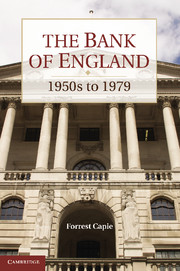Book contents
- Frontmatter
- Contents
- List of Illustrations
- List of Figures
- List of Tables
- Foreword by Mervyn King
- Preface
- Acknowledgements
- Abbreviations and Acronyms
- 1 Introduction and Overview
- 2 The Bank in the 1950s
- 3 The Monetary Setting and the Bank
- 4 The Bank's External Responsibilities to 1964
- 5 From Crisis to ‘Crucifixion’
- 6 Domestic Monetary Policy after Radcliffe
- 7 Other Activities and Performance
- 8 Sterling from Devaluation to Smithsonian
- 9 The Road to Competition and Credit Control
- 10 Competition and Credit Control
- 11 The Secondary Banking Crisis
- 12 Banking Supervision
- 13 Monetary Targets and Monetary Control
- 14 The Bank and Sterling in the 1970s
- 15 The Bank's Freedom to Operate
- 16 Epilogue
- Bibliography
- Index
- Titles in the series
7 - Other Activities and Performance
Published online by Cambridge University Press: 05 July 2011
- Frontmatter
- Contents
- List of Illustrations
- List of Figures
- List of Tables
- Foreword by Mervyn King
- Preface
- Acknowledgements
- Abbreviations and Acronyms
- 1 Introduction and Overview
- 2 The Bank in the 1950s
- 3 The Monetary Setting and the Bank
- 4 The Bank's External Responsibilities to 1964
- 5 From Crisis to ‘Crucifixion’
- 6 Domestic Monetary Policy after Radcliffe
- 7 Other Activities and Performance
- 8 Sterling from Devaluation to Smithsonian
- 9 The Road to Competition and Credit Control
- 10 Competition and Credit Control
- 11 The Secondary Banking Crisis
- 12 Banking Supervision
- 13 Monetary Targets and Monetary Control
- 14 The Bank and Sterling in the 1970s
- 15 The Bank's Freedom to Operate
- 16 Epilogue
- Bibliography
- Index
- Titles in the series
Summary
In the 1950s and 1960s, the Bank performed a number of functions that would no longer be considered central bank business and might even baffle a student of modern central banking. For example, a legacy of the interwar years, it continued to participate in organising and, on occasion, supplying industrial finance. It also took a keen interest in anything that affected the City; it oversaw all merger activity. It became heavily engaged in anything it felt was for the greater good of central banking and spent time and money on promoting central banking abroad. In addition, it had direct responsibility for a range of things such as note issue, and it frequently would be called on to give advice, often extensive in its coverage, on subjects such as decimalisation. This chapter describes its activities in some of these fields and concludes with an assessment of the Bank's financial position at the end of the 1960s. The results of other assessments, one by management consultants that the Bank appointed and the other by a select committee to which they agreed to submit, are also noted.
Industrial Finance
The Bank had been closely involved in the financing of industry from the 1920s. Montagu Norman had engaged in it as one way of deflecting interference from the state, and then, following the Macmillan Report, the Bank established an Industrial Finance Division that continued until late in the twentieth century.
- Type
- Chapter
- Information
- The Bank of England1950s to 1979, pp. 318 - 371Publisher: Cambridge University PressPrint publication year: 2010



